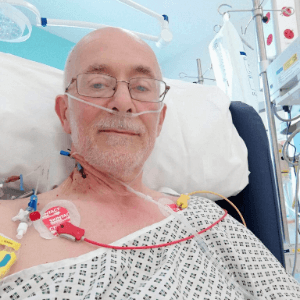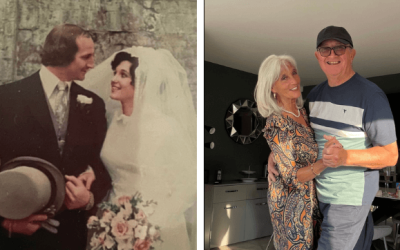
I had an ultrasound scan that November where they said there was a large ‘mass’ in my abdomen and, in December, I had a CT scan. The report indicated ‘chronic liver disease’. In January 2022 I was telephoned by a specialist from the Royal Stoke Hospital who confirmed I had liver cirrhosis and we discussed what the next steps would be.
However, nothing further was done in respect of my ‘liver disease’ because in early February my umbilical hernia was giving me a lot of pain and I went to Accident & Emergency (A&E). The following day I had three and a half litres of fluid drained and they kept me in. This was the first time in my life I had stayed overnight in a hospital, being a normal fit and healthy chap until now.
An overnight stay eventually turned out to be 17 nights! I was operated on for the strangulated hernia which included the loss of my belly button. Tests were done and the surgeon informed me later that ‘cancerous activity’ had been found and further tests were being done to determine exactly what the cancer was.
This was during the covid crisis and for the first two weeks I wasn’t allowed any visitors. I had to settle with video calls to my wife, Alison, and the rest of the family. The granddaughters made cards for me, I was missing everyone terribly but kept my spirits up by issuing humorous ‘patient updates’ to everyone using messaging. How did we manage without smart phones?
A few days later I was informed that I had pseudomyxoma peritonei (PMP) and they were referring me to The Christie specialist cancer hospital in Manchester. There was nothing wrong with my liver. The nurse had to write it down my diagnosis for me!
I was admitted to The Christie in April and remained there for six nights. They had hoped to undertake the debulking procedure¹ but this stopped once they had opened me up due to the extensive hard nature of the disease. I had already been advised that I was not a candidate for cytoreductive surgery² and HIPEC³.
My specialist suggested I undergo a course of systemic chemotherapy, although the success rate is not that good. From July to December 2022, I had eight cycles of oxaliplatin infusions and capecitanine tablets.
The result of the chemo is that my tumour markers have fallen considerably and the growth in my abdomen has stabilised. I am now seeing my oncologist every six weeks or so with the occasional CT scan. Although recently I do feel that I’m starting to expand again.
Life is tough at the moment, although I’ve lost a lot of muscle mass, I’m walking around with an enormous belly and feel tired most of the time. Thankfully, I do have fantastic support from my family and friends, especially from my lovely caring wife Alison.
~Gary
Complete cytoreduction
Complete cytoreduction is the complete surgical tumour removal. This is a long operation which takes about 10 hours to complete and includes:
- removal of the right hemicolon
- spleen
- gall bladder
- greater omentum and lesser omentum
- stripping of the peritoneum from the pelvis and diaphragms
- tripping of tumour from the surface of the liver
- removal of the uterus and ovaries in women
- removal of the rectum in some cases
This is also referred to as a full peritonectomy. The goal is to remove tumour nodules down to 2.5mm.
Debulking
Debulking is a surgical procedure that is used to remove as much cancerous tissue as possible. The aim of debulking is to improve the effectiveness of other cancer treatments such as chemotherapyby reducing the amount of cancerous tissue that needs to be targeted. It can also help to alleviate symptoms and improve the patient’s quality of life.
HIPEC
Hyperthermic Intraperitoneal Chemotherapy
Heated chemotherapy, delivered directly into the abdomen, after complete cytoreduction. If the surgeons are able to remove the all the tumours, you may be given HIPEC.
Hyperthermic means that the chemotherapy solution used during the procedure is heated to a higher-than-normal temperature, typically around 41-43°C (105.8-109.4°F). This is usually Mitomycin C. This is put directly in your abdomen while you are in theatre. This elevated temperature is maintained throughout the duration of the procedure, usually around 90 minutes, to enhance the effectiveness of the chemotherapy drugs and to target cancer cells in the abdominal cavity. HIPEC will penetrate tumour nodules up to 2.5mm in size. The combination of chemotherapy drugs and hyperthermia can help to destroy cancer cells (increased cytotoxicity) while minimizing damage to healthy tissue.
Chemotherapy given into the abdomen during surgery is called intraoperative chemotherapy.
In case you missed it...
Surviving with pseudomyxoma peritonei
When I was diagnosed in with PMP in 1999, there was no information, no glossy pamphlets, no specialist nurses, no web site, NOTHING.
My PMP journey and why I’m doing my bit to raise awareness
I was diagnosed with PMP aged 32, after many months of stomach pains, bloating, constipation and irregular periods. After numerous trips to my GP, which led to an ultrasound and eventually a CT scan, I was told I had a nine centimetre tumour on my appendix which had burst and leaked cancerous mucin into my abdominal cavity.
In sickness and in health
On the 4th May 1974, we married in the beautiful Christchurch Priory which was then Hampshire and is now Dorset, to have and to hold from this day forward. I didn’t realise how important the words in our vows “in sickness and in health” were at the time.




